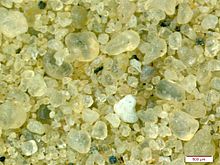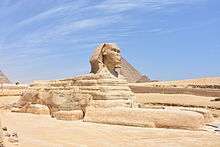Western Desert (Egypt)
Western Desert
الصحراء الغربية | |
|---|---|
| Country | Egypt |
The Western Desert of

Administratively the Western Desert is divided between various governorates; in the north and west, the Matrouh Governorate administers the area from the Mediterranean south to approx 27°40' N latitude, and the New Valley Governorate from there to the Sudan border, while in the east parts of the Western Desert lie in the Giza, Fayyum, Beni Suef, and Minya Governorates.
Geography
The region is described by one writer as "a plateau standing on average some 500 feet [150 m] above sea level, barren, rubble- and boulder-strewn, dark brown in colour, occasionally dotted with scrub, and, at first sight, flat".
To the south, beyond the Bahariya oasis lies the
In the south-west, near the point where the borders of Libya, Sudan and Egypt meet, is an area of
The Great Sand Sea is a roughly lung-shaped area of sandy desert lying astride the border with Libya, 320 km (200 mi) inland from the Mediterranean. The sea is divided by a long peninsula of rocky desert along the border, leaving the eastern lobe in Egypt and the western in Libya, where it is called the Calanshio desert. On the Egyptian side it was known historically as the "Libyan Desert", taking its name from Ancient Libya, which lay between the Nile and Cyrenaica. With the formation of the state of Libya, the term "Western Desert" has come to describe the part of the Sahara in Egypt.
Boundaries
To the Ancient Greeks, the term Libya described the whole Saharan littoral west of the Nile to the Atlas Mountains. In Roman times, the term Libya was limited to Cyrenaica and the region between there and Egypt, organized as the provinces of Libya Superior and Libya Inferior. The term Libyan Desert then applied to the area to the south of these provinces. This became a misnomer during colonial times when Cyrenaica and the land to the west was organized as the Italian colony of Libya in 1911, and the term Western Desert used to describe the area within Egypt became more common.
Playfair described the Western Desert of 1940 as 390 km (240 mi) wide (i.e. from the Nile to the Libyan border) and 240 km (150 mi) from the Mediterranean to the latitude of Siwa Oasis, while the region to the south was referred to as the Inner Desert.[4] However, during the Second World War the term Western Desert came to apply not only to the coastal desert of Egypt but also to the area fought over in Libya, ranging beyond the Egypt-Libya border to Gazala, Cyrenaica and even El Agheila.
The contemporary use of the term refers to the entire desert in Egypt west of the Nile.[1][5]
List of Deserts
Giza Plateau
The Giza Plateau (هضبة الجيزة) is a
, several cemeteries, a workers' village and an industrial complex.The Giza pyramid complex (مجمع أهرامات الجيزة), also called the Giza necropolis and also known as the Pyramids of Giza or Egypt, is the site on the Giza Plateau in Giza and Greater Cairo, Egypt that includes the Great Pyramid of Giza, the Pyramid of Khafre, and the Pyramid of Menkaure, along with their associated pyramid complexes and the Great Sphinx of Giza. All were built during the Fourth Dynasty of the Old Kingdom of Ancient Egypt, between 2600 and 2500 BC. The site also includes several cemeteries and the remains of a workers' village.
The Giza pyramid complex consists of the

The Great Sphinx of Giza is a limestone statue of a reclining sphinx, a mythical creature with the head of a human, and the body of a lion. Facing directly from west to east, it stands on the Giza Plateau on the west bank of the Nile in Giza, Egypt. The face of the Sphinx appears to represent the pharaoh Khafre.
The original shape of the Sphinx was cut from the
The Sphinx is the oldest known
Great Sand Sea

The Great Sand Sea is a desert in the Sahara between western Egypt and eastern Libya in North Africa, 74% of the area is covered by sand dunes.
The Great Sand Sea stretches about 650 km (400 mi) from north to south and 300 km (190 mi) from east to west. On satellite images this desert shows a pattern of long sand ridges running in a roughly north–south direction. However, despite the apparent uniformity the Great Sand Sea has two large areas with different types of megadunes. The Egyptian sand sea lies parallel to the Calanshio Sand Sea of Libya, with which it is contiguous in the north. The dunes of the Great Sand Sea cover about 10% of the total area of the Western Desert.
Black Desert

The Black Desert (الصحراء السوداء) is a region of volcano-shaped and widely spaced mounds, distributed along about 30 km (19 mi) in the Western Desert between the White Desert in the south and the Bahariya Oasis in the north. Most of its mounds are capped by basalt sills, giving them the characteristic black color.
The mounds of the Black Desert, up to 100 metres (330 feet) high, vary in size, composition, height, and shape as some are dark consisting of iron
White Desert
The White Desert is a
The park is the site of large white chalk rock formations, created through erosion by wind and sand. It is also the site of cliffs (at the northern end of the Farafra Depression), sand dunes (part of the Great Sand Sea), as well as Wadi Hennis and oases at Ain El Maqfi and Ain El Wadi.
The park serves as the refuge for various animals, including the endangered Rhim gazelle and the vulnerable Dorcas gazelle, as well as Barbary sheep; jackals; Rüppell's, red and fennec foxes; and the sand cat.
History

In pre-historic times the Western desert is thought to have been a semi-arid
In ancient times the area was regarded as being under the jurisdiction of the kingdom of Egypt, and Egyptian remains can be found in all the oases. In 525 BC, the
With the absorption of the kingdom of Egypt into the Roman Empire, the desert region was organized into the province of Libya Inferior, while Cyrenaica became Libya Superior. In time the region came under the jurisdiction of the Byzantines and their successors, the Arabs, Mamluks and Turks. In 1882 the kingdom of Egypt became a British protectorate, and in 1912 the territory to the east was claimed by Italy as the colony of Libya.
In the 20th century the Western Desert became an arena of conflict; during the
In modern times the Egyptian government has encouraged settlements in the oases, and surveyed for minerals, particularly oil.
Western Desert -"Toshka Project"
In October 2020, President Abdul Fattah el-Sisi ordered the revival of an ambitious decades old agricultural project once named the Toshka Project (aka the New Valley Project), aimed at creating a new delta in the middle of Western Desert and increasing living space and prosperity for Egypt's growing population.[9] President El-Sisi specified that 6.4 billion Egyptian pounds ($413 million) would be needed for the necessary infrastructure, breathing new life into national hopes for turning the desert green. Originally, Project Toshka was spear-headed by former President Hosni Mubarak, who spent 40 billion Egyptian pounds on the project, establishing the necessary electricity plants and water pumping stations.[10] A few years later, however, the project came to a sudden halt, with failure being attributed to the lack of political will and necessary investments.[9]
Notes
- ^ a b Western Desert at Encyclopædia Britannica
- ^ a b Pitt p13
- ISBN 978-1-86064-548-8.
- ^ Playfair pp115-117
- ^ Western Desert at countrystudies.us (Library of Congress)
- ^ Firestone pp320-367
- ^ Sattin pp267-293
- ^ Thompson, Folkard pp252-263
- ^ a b "Egypt revives Western Desert agricultural project - Al-Monitor: The Pulse of the Middle East". www.al-monitor.com. Retrieved 2022-01-06.
- ^ "Mubarak: Toshka Project Opens Way Towards New Civilization In Egypt". american_almanac.tripod.com. Retrieved 2022-01-06.
References
- Firestone: Egypt (10th ed 2010) Lonely Planet ISBN 978-1-74179-314-7
- McLachlan: Egypt (3rd ed 2000) Footprint Guides ISBN 1 900949 68 7
- Pitt: The Crucible of war: Western Desert 1941 (1980) Jonathan Cape ISBN 0 224 01771 3
- Playfair: War in the Mediterranean vol I (1956) HMSO ISBN (none)
- Sattin: Discover Egypt (2nd ed 2012) Lonely Planet ISBN 978-1-74220-224-2
- Thompson, Folkard: Egypt Dorling Kindersley (2001; reprint 2011) ISBN 978 1 4053 5787 6







